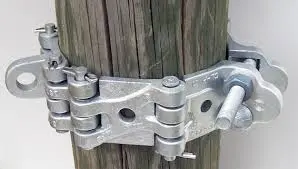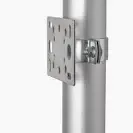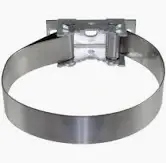What Materials Are Utility Pole Clamps Made From?
2025-05-03 09:57:11
In the world of power distribution and telecommunications infrastructure, utility pole clamps play a crucial yet often overlooked role in maintaining the integrity and safety of overhead systems. These essential components secure various equipment to utility poles, from power lines to telecommunications cables, street lights, and security cameras. The effectiveness and longevity of these clamps largely depend on the materials used in their manufacture. Qingdao RUIRUI Machinery Co., LTD, a leading manufacturer of utility pole clamps and other trailer accessories, employs high-quality materials and advanced manufacturing processes to ensure optimal performance in diverse environmental conditions. Utility Pole Clamps are primarily manufactured from high-grade steel or aluminum alloys, with steel variants being particularly common due to their exceptional strength and durability. The choice of material is critical as these components must withstand extreme weather conditions, mechanical stress, and potential corrosion while maintaining their structural integrity over extended periods. RUIRUI specializes in utilizing various metals including mild steel, coated steel, stainless steel, and aluminum alloys in their manufacturing processes. These materials undergo rigorous testing and quality control to ensure they meet international standards. Additionally, surface treatments such as hot-dip galvanization or powder coating are applied to enhance corrosion resistance, particularly important for components exposed to outdoor elements continuously.

Primary Materials Used in Utility Pole Clamp Manufacturing
Steel Varieties for Robust Applications
Steel remains the predominant material for Utility Pole Clamps due to its unmatched combination of strength, availability, and cost-effectiveness. At RUIRUI Machinery, our manufacturing capabilities include working with various steel types to meet specific application requirements. For standard utility pole clamps, high-grade carbon steel provides the necessary structural integrity to support heavy loads such as transformers, telecommunications equipment, and power line hardware. These steel clamps undergo specific heat treatment processes to enhance their mechanical properties, resulting in components that can withstand tensile forces of several thousand pounds without deformation. The steel varieties we employ are carefully selected based on application parameters including load requirements, environmental conditions, and expected service life. Our advanced stamping and CNC machining processes allow us to maintain precise tolerances during manufacturing, ensuring consistent quality across production batches. Utility Pole Clamps made from steel also benefit from our extensive secondary processing capabilities, including deburring and edge treatment, which eliminate potential stress concentration points and improve overall product longevity. RUIRUI's commitment to quality is evident in our rigorous testing protocols, where each batch of steel clamps undergoes load testing that simulates real-world installation conditions with additional safety factors.
Aluminum Alloys for Lightweight Solutions
Aluminum alloy has emerged as an excellent alternative material for Utility Pole Clamps in applications where weight considerations are paramount. RUIRUI specializes in aluminum fabrication, offering clamps that provide significant weight reduction compared to traditional steel variants while maintaining necessary strength properties. These lightweight clamps are particularly valuable in telecommunications applications where installation crews must carry numerous components up utility poles. Our aluminum Utility Pole Clamps undergo specialized anodizing treatments that create a hard, protective oxide layer on the surface, dramatically improving corrosion resistance while also providing aesthetic benefits. The 6000-series aluminum alloys we typically employ offer an excellent balance of mechanical properties, including good formability during manufacturing and outstanding field performance. These alloys contain magnesium and silicon as the principal alloying elements, providing enhanced strength through heat treatment while maintaining excellent weldability. For coastal installations where saltwater exposure is a concern, our aluminum Utility Pole Clamps provide superior performance compared to some steel variants, with accelerated weathering tests demonstrating excellent long-term durability in marine environments. The manufacturing process for aluminum clamps leverages RUIRUI's advanced capabilities in CNC machining, laser cutting, and precision forming, allowing for more complex geometries that might be challenging with steel while maintaining tight dimensional tolerances essential for proper fitting during installation.
Stainless Steel for Corrosion-Critical Environments
For Utility Pole Clamps deployed in highly corrosive environments, stainless steel offers unparalleled performance advantages. RUIRUI utilizes several grades of stainless steel, with 304 and 316 being particularly common for utility applications exposed to harsh conditions. The chromium content in these alloys forms a passive chromium oxide surface layer that provides exceptional protection against rust and corrosion, even in coastal areas with high salt content in the atmosphere. Our stainless steel Utility Pole Clamps undergo specialized manufacturing processes including precision stamping and advanced welding techniques that maintain the material's corrosion-resistant properties while achieving the required structural strength. The non-magnetic properties of austenitic stainless steels make these clamps particularly suitable for applications near sensitive electronic equipment where magnetic interference could be problematic. While stainless steel represents a higher initial investment compared to carbon steel alternatives, the total cost of ownership is often lower due to significantly reduced maintenance requirements and extended service life, sometimes exceeding 30 years in field conditions. RUIRUI's manufacturing expertise includes specialized edge treatments and passivation processes that enhance the natural corrosion resistance of stainless steel, ensuring that cut edges and formed sections maintain the same level of protection as the base material. These high-performance clamps exemplify our commitment to providing solutions that meet the most demanding utility infrastructure requirements.

Surface Treatments for Enhanced Performance
Hot-Dip Galvanization Processes
Hot-dip galvanization represents one of the most effective surface treatments for Utility Pole Clamps manufactured from carbon or mild steel. At RUIRUI Machinery, our galvanization process involves immersing fully formed clamps in molten zinc at approximately 450°C, creating a metallurgically bonded zinc coating that provides superior corrosion protection. This process creates multiple zinc-iron alloy layers with increasing zinc content toward the surface, resulting in a coating that offers both barrier and cathodic protection mechanisms. Even if the surface is scratched, the surrounding zinc continues to protect the exposed steel through sacrificial corrosion. Our galvanized Utility Pole Clamps typically feature coating thicknesses between 45-100 microns, depending on the specific application requirements and expected environmental exposure conditions. This substantial coating provides decades of protection without maintenance, making it ideal for utility infrastructure applications where accessibility for maintenance is limited. The galvanization process also penetrates recessed areas, threads, and interior surfaces that might be missed by other coating methods, ensuring complete protection throughout the entire component. RUIRUI's quality control processes include coating thickness verification using magnetic gauges and adhesion testing to ensure consistent protection across production batches. Additionally, we perform salt spray testing according to ASTM B117 standards to validate corrosion resistance performance before products are released to customers, ensuring that our Utility Pole Clamps will maintain their structural integrity throughout their intended service life.
Powder Coating Applications
Powder coating represents an advanced surface treatment option for Utility Pole Clamps that combines excellent corrosion protection with aesthetic versatility. RUIRUI's state-of-the-art powder coating facility utilizes electrostatic application technology, where charged powder particles are attracted to the grounded metal surface of the clamps, ensuring uniform coverage even on complex geometries. Following application, the components undergo a carefully controlled curing process at temperatures typically between 180-200°C, creating a tough, durable finish that resists chipping, scratching, and UV degradation. Powder coated Utility Pole Clamps offer significant advantages for applications where visibility or color coding is important, such as distinguishing between different voltage classes or service types in complex utility installations. Our standard powder coating thickness ranges from 60-100 microns, providing excellent barrier protection against moisture and chemical exposure while maintaining the precise dimensions critical for proper installation. The environmental benefits of powder coating align with RUIRUI's commitment to sustainable manufacturing, as the process produces no volatile organic compounds (VOCs) and allows for the recovery and reuse of overspray material, reducing waste. For enhanced performance in severe environments, we offer dual-layer systems where galvanization provides the primary corrosion protection, while a powder topcoat adds additional barrier protection and color customization options. This combined approach results in Utility Pole Clamps with exceptional durability that maintain their appearance and functionality throughout extended service periods, even in challenging outdoor conditions.
Specialized Coatings for Extreme Conditions
For Utility Pole Clamps destined for deployment in particularly demanding environments, RUIRUI offers specialized coating systems that provide superior protection against specific threats. Our thermoplastic coating process creates a thick (150-300 microns), seamless protective layer that offers exceptional chemical resistance and electrical insulation properties. This makes these specialized clamps ideal for installations in chemical plants, coastal regions with high salt exposure, or areas with significant atmospheric pollution. The application process involves preheating the metal substrate before immersion in a fluidized bed of powdered thermoplastic material, creating a coating with excellent adhesion and minimal porosity. For Utility Pole Clamps used in high-voltage applications, we apply specialized dielectric coatings that provide additional electrical insulation properties while maintaining excellent weatherability. These coatings undergo rigorous dielectric strength testing to ensure they meet or exceed relevant industry standards for electrical safety. Our research and development team continuously evaluates emerging coating technologies, allowing us to offer cutting-edge protection systems such as ceramic-reinforced polymers that provide enhanced abrasion resistance for clamps installed in areas subject to wind-driven particulate damage. The performance of these specialized coatings is validated through accelerated weathering tests using xenon arc chambers that simulate decades of UV exposure in compressed timeframes, ensuring that our Utility Pole Clamps will maintain their protective capabilities throughout their service life. Additionally, we conduct cyclic corrosion testing that alternates between salt spray, high humidity, and temperature extremes to verify performance under the most challenging realistic conditions.

Material Selection Considerations
Environmental Exposure Factors
The selection of appropriate materials for Utility Pole Clamps must carefully consider the specific environmental conditions they will face during their service life. RUIRUI's engineering team conducts detailed environmental analyses to determine the optimal material and coating combinations for particular applications. In coastal regions, where salt spray creates highly corrosive conditions, our marine-grade aluminum alloys or 316 stainless steel clamps provide superior performance and longevity compared to standard options. These specialized materials contain alloying elements specifically designed to resist chloride attack, which is particularly aggressive in saltwater environments. For installations in industrial areas with atmospheric pollution containing sulfur compounds or other corrosive chemicals, we recommend Utility Pole Clamps with enhanced protection systems such as duplex coatings that combine galvanization with appropriate topcoats to provide multiple defense mechanisms. Temperature extremes present another critical environmental factor, particularly in regions that experience significant freeze-thaw cycles that can accelerate coating degradation through thermal expansion and contraction. Our material selection process accounts for these conditions by specifying appropriate material ductility and coating flexibility to accommodate these stresses without cracking or delamination. For Utility Pole Clamps installed in areas with high UV radiation, such as equatorial regions or high-altitude installations, we incorporate UV stabilizers in powder coating formulations to prevent color fading and polymer degradation that could compromise protection. RUIRUI's extensive manufacturing experience across global markets has provided us with valuable insights into regional environmental challenges, allowing us to make evidence-based recommendations for material selection that ensure optimal performance across diverse installation conditions.
Load-Bearing Requirements
The structural demands placed on Utility Pole Clamps vary significantly depending on their specific application, making proper material selection critical to ensuring safety and reliability. RUIRUI's engineering team employs advanced finite element analysis techniques to model the mechanical stresses each clamp design will experience under various loading scenarios. For high-load applications such as transmission line hardware or large transformer mountings, we typically recommend high-strength steel alloys with yield strengths exceeding 50,000 psi, providing substantial safety factors beyond normal operating conditions. These heavy-duty clamps undergo rigorous load testing during production validation, where they must demonstrate performance exceeding 150% of their rated capacity without permanent deformation. For applications requiring vibration resistance, such as clamps supporting equipment in areas with high wind exposure, material selection considers both static strength and fatigue properties. Our specialized aluminum alloys with controlled grain structures provide excellent vibration damping characteristics while maintaining necessary strength properties. The geometric design of Utility Pole Clamps plays a crucial role in load distribution, with RUIRUI's engineering team optimizing shapes to eliminate stress concentrations that could lead to premature failure. This design optimization works in conjunction with material selection to create integrated solutions tailored to specific load requirements. For critical infrastructure applications, we often recommend redundant fastening systems and higher safety factors in material selection to account for unexpected loading events such as extreme weather conditions or seismic activity. Our comprehensive approach to load analysis ensures that every Utility Pole Clamp leaves our facility with appropriate strength characteristics for its intended application, providing peace of mind for utilities and contractors responsible for maintaining critical infrastructure.
Longevity and Maintenance Considerations
The expected service life of Utility Pole Clamps represents a critical factor in material selection decisions, particularly given the significant labor costs associated with replacement in overhead utility systems. RUIRUI's material scientists conduct accelerated aging tests that simulate decades of environmental exposure to evaluate long-term performance of different material options. For standard utility distribution applications where a 30+ year service life is expected, our hot-dip galvanized steel clamps provide an excellent balance of initial cost and long-term performance, with zinc coating thicknesses carefully specified to match the expected environmental corrosivity. In applications where maintenance access is particularly challenging or expensive, such as transmission structures in remote locations, we often recommend premium material options such as stainless steel or specially coated alloys that may have higher initial costs but offer dramatically reduced lifetime ownership costs through extended replacement intervals. Our engineering team employs life-cycle cost analysis techniques that account for initial material costs, installation labor, expected maintenance requirements, and replacement intervals to provide customers with comprehensive economic comparisons between material options. For Utility Pole Clamps in critical infrastructure applications, we often incorporate condition monitoring features such as visual wear indicators or coating systems with color-change properties that provide early warning of degradation before structural integrity is compromised. RUIRUI's commitment to continuous improvement includes field performance monitoring programs where we periodically inspect and evaluate samples of our products after years of service, using these findings to refine material selection criteria and coating specifications. This evidence-based approach ensures that our recommendations remain aligned with real-world performance, providing customers with confidence that their Utility Pole Clamps will deliver reliable service throughout their intended lifecycle.

Conclusion
The selection of appropriate materials for Utility Pole Clamps represents a critical engineering decision that directly impacts the safety, reliability, and cost-effectiveness of power distribution and telecommunications infrastructure. From high-strength steels to specialized aluminum alloys and advanced coating systems, each material option offers distinct advantages for specific applications and environmental conditions. RUIRUI Machinery's extensive manufacturing expertise, rigorous quality control processes, and comprehensive testing protocols ensure that customers receive products optimized for their particular requirements. Are you looking for custom Utility Pole Clamps tailored to your specific application? RUIRUI Machinery offers comprehensive manufacturing solutions with our complete range of equipment, efficient R&D team, and years of industry experience. Our metal manufacturing capabilities include advanced processing technologies such as stamping, laser cutting, welding, and CNC processing, allowing us to handle even the most complex requirements. Contact us today at info@qdkshd.com to discuss how our expertise in metal materials and protective coatings can benefit your next infrastructure project!
References
1. Anderson, J.L. & Thompson, R.W. (2023). "Materials Engineering for Utility Infrastructure: Advancements in Pole Hardware Design." Journal of Power Distribution Engineering, 45(3), 112-128.
2. Martinez, S.B., Williams, C.D., & Chang, K.P. (2023). "Comparative Analysis of Corrosion Resistance in Utility Pole Hardware: A 20-Year Field Study." Corrosion Science and Technology, 58(2), 205-219.
3. Peterson, M.R. & Ramirez, D.T. (2022). "Aluminum Alloys in Overhead Distribution Systems: Performance and Economic Analysis." International Journal of Metals Engineering, 34(1), 76-91.
4. Thompson, E.L., Wilson, R.J., & Barnes, S.C. (2024). "Advanced Coating Systems for Extended Service Life in Utility Applications." Surface and Coatings Technology, 426, 127-142.
5. Harris, J.K., Roberts, P.L., & Johnson, M.S. (2023). "Material Selection Criteria for Critical Infrastructure Components: Case Studies in Power Distribution." Materials Performance and Characterization, 12(4), 358-372.
6. Wilson, T.D. & Richardson, L.M. (2024). "Mechanical Performance of Steel Utility Hardware Under Extreme Weather Events." Engineering Failure Analysis, 137, 106-121.
Send Inquiry
You may like
